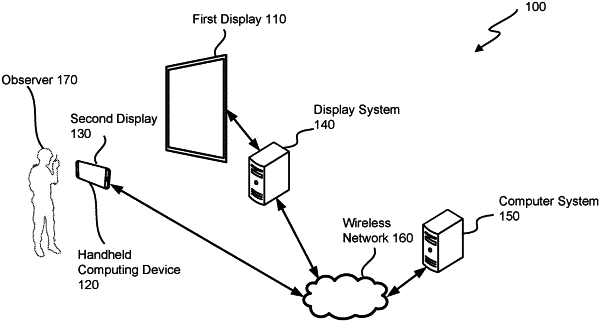| CPC G06F 3/1423 (2013.01) [G06F 3/011 (2013.01); G06F 3/167 (2013.01); G06T 15/00 (2013.01); G10L 15/18 (2013.01); G10L 15/22 (2013.01); G10L 2015/223 (2013.01)] | 21 Claims |

|
1. A synchronization system for providing synchronization between screens, the system comprising:
a first display mounted in a fixed position;
a computer system coupled to the first display; and
a handheld computing device, comprising:
a second display, wherein:
the first display is larger than the second display;
the first display has a wider field of view than the second display;
the first display establishes an optical link with the second display;
the first display renders a virtual reality model of a scene with moving objects and asynchronous visual events;
the scene and the asynchronous visual events rendered on the first display are rendered on the second display;
a machine-readable code is embedded in asynchronous visual events and is visually readable by the handheld computing device;
the handheld computing device is configured to:
scan the machine-readable code having coordinates of the asynchronous visual events and coordinates of the moving objects within the scene;
transmit the location coordinates of the asynchronous visual events and the coordinates of the moving objects within the scene to one or more remote computing devices using one or more wireless link; and
in response to transmission of the coordinates of the asynchronous visual events and the coordinates of the moving objects within the scene,
transform the virtual reality model of the scene rendered on the first display.
|